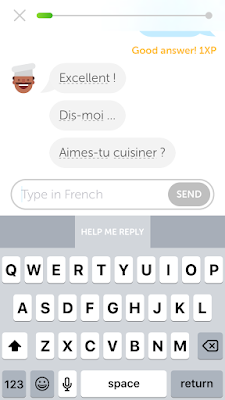As you can see by the filled-in gold boxes, I have already participated in five different chats with bots. The topics are familiar ones taken from daily life, such as weather, family, and food. I must admit I was hooked immediately into a new way of practicing languages.
Duolingo has been a daily activity for me for several years. (An 881 day streak at last count!) I enjoy keeping up with familiar languages, like French, Portuguese, and Spanish and also learning new languages, like Irish and Welsh. But I always knew the best way to learn languages was to use the language for real communication.
Chatting with bots is the closest online experience I have had to real world language use. A bot greets you, introduces a topic, and asks questions to which you type in an answer. Basically what you are doing is texting in a foreign language with a bot.
Several features of the chat keep the conversation running smoothly. First, a variety of answers are accepted and responded to. If you get too far off track, the program won't let you input your answer, but it does correct small spelling errors and offers to help if you get stuck. For example, the bot asked what I wanted on my pizza besides tomato, and I couldn't think of the French word for "onion." Clicking on help provided the quick translation, oignon.
Another great feature of the chat is the use of "filler words," words that we use to oil the wheels of communication. The Spanish bot may answer with genial (great) or qué bien (well done) before going on to the next topic.
And the French bot may use excellent as a way of making the conversation more personal and less like a grammar exercise.
Chat responses are scored to increase the number of your XPs (experience points) on Duolingo. An acceptable answer gets one point, an exceptional answer gets two points, but if you accept help, you do not get any points. Another great motivational feature of Duolingo!
So is chatting with a bot identical to a real life experience using the language? No, it is close but still not real world. In life, communication in a foreign language with a person can be very intimidating, perhaps less so when texting to that person, but still anxiety producing. Your real life language partner may be impatient and critical or use a lot of slang. Chatbots are calm and supportive and use standard language.
The chatbot experience on Duolingo makes the learner formulate thoughts in the foreign language and put them into words. What a huge step forward from most drill and practice language lessons! Chatbots are now available on Duolingo in Spanish, French, and German, with other languages promised soon. I have only found chats on my iPhone, but I'm sure other platforms are on the way.
Will the next step on Duolingo be communicating verbally with a bot rather than texting? I have my fingers crossed for what the future may bring to the language learning experience!



No comments:
Post a Comment